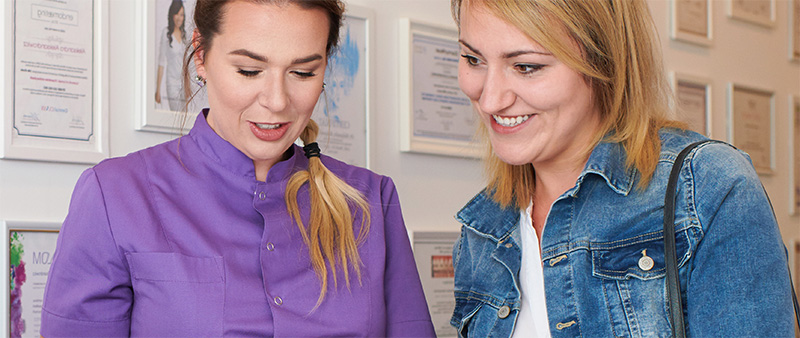Veneers
Aesthetic stomatology allows us to remove imperfections of the patient’s dentition. The teeth act as our businesscards, and their good looks influence our self-confidence, which is why veneers are one of the solutions we offer.Veneers provide one of many methods whereby the aesthetic aspect of the smile can be improved. They are thin flakes, most often made of porcelain, which are fixed with glue to the lip-side surface of the teeth. Due to their specific character, they can be used in aesthetic dentistry as well as in prosthetics.
What veneers are?
What exactly are veneers? They belong to the category of fixed prosthetic restorations, which are fixed permanently to the patient’s teeth and resemble fine flakes made of composite materials or porcelain. Veneers improve the looks of the teeth; they can correct minor faults and discolourations, change the shape of the tooth and correct minor instances of malocclusion. It is important, however, to point up that veneers are used tofix damaged teeth only if the scope of the lesionis minor and it does not affect the pulp.
Veneers are fixed to the external side of the teeth, andapart from improving the aesthetic aspect of the dentition, they also replace the enamel.As they constitute part of dental restoration, veneers are subject to wear-and-tear, and it is important to remember about the follow-up appointments, which allow the specialist to check the conditions of the patient’s dentition and if the veneers are secured properly.After a certain period of time, they have to be replaced; the durability of the composite veneers is approximately 5 years, and their ceramic counterparts last roughly 15 years.
Veneers offer a vast array of advantages:
- They improve the shape of the patient’s teeth
- Hide discolourations and non-aesthetic fillings of the front teeth
- Adjustments to minor instances of teeth crowding, teeth rotation
- Improvements to the colour of the teeth
- Restoration of teeth cracks and fractures resulting from injury
How are veneers made?
The process begins with a thorough examination of the patient’s teeth; If the stomatologist discovers instances of lesions (e.g decay) or too large an amount of deposit and scale, it will not be possible to fix the veneers. Before the treatment, the teeth have to be healed and thoroughly cleaned (usually, after the treatment thoroughteeth cleaning is performed). Only the teeth which have been prepared in such a way are fit to be improved by means of veneers.
How are they made? First, the specialist takes the impression of the patient’s teeth and uses it subsequently to design the veneers.Next, the patient tries on the sample work to see, if the outcome is satisfactory; if adjustments are necessary, they will be made before the next visit.The ready design, that has been approved, is sent to the prosthetic laboratory, where proper prosthetic work begins. While waiting for the laboratory to send the device, the dentist works on the patient’s teeth, which require delicate polishing; this ensures impeccable clinging of the veneers to the surface of the teeth. After polishing and before the final prosthetic restoration is ready, the so-called temporal veneers are secured to the teeth.Their purpose is to protect polished teeth from external factors. Ready veneers are secured to the teeth with special dental cement.
Veneers can be made of porcelain or composite material, however, the former presents a far more durable alternative- porcelain-made veneers last longer.The aesthetic value behind both types of material used is also distinguishable; porcelain devices perfectly imitate the enamel and they look very natural. Also, these devices match the colour of the rest of the teeth really well. Porcelain and composite materials also differ based on their light-transmission capability. Light dispersion in the porcelain veneer is similar to the one which occurs in a natural tooth.Composite veneers’ colour, on the other hand, is usually consistent andits light dispersion is different than in natural tooth. What is more, with time food-related deposits might begin to build upon their surface, which is uncommon among porcelain veneers; as a result, appointments to polish the device and remove prospective deposits are required every six months.







 Prosthetic dentistry
Prosthetic dentistry 


